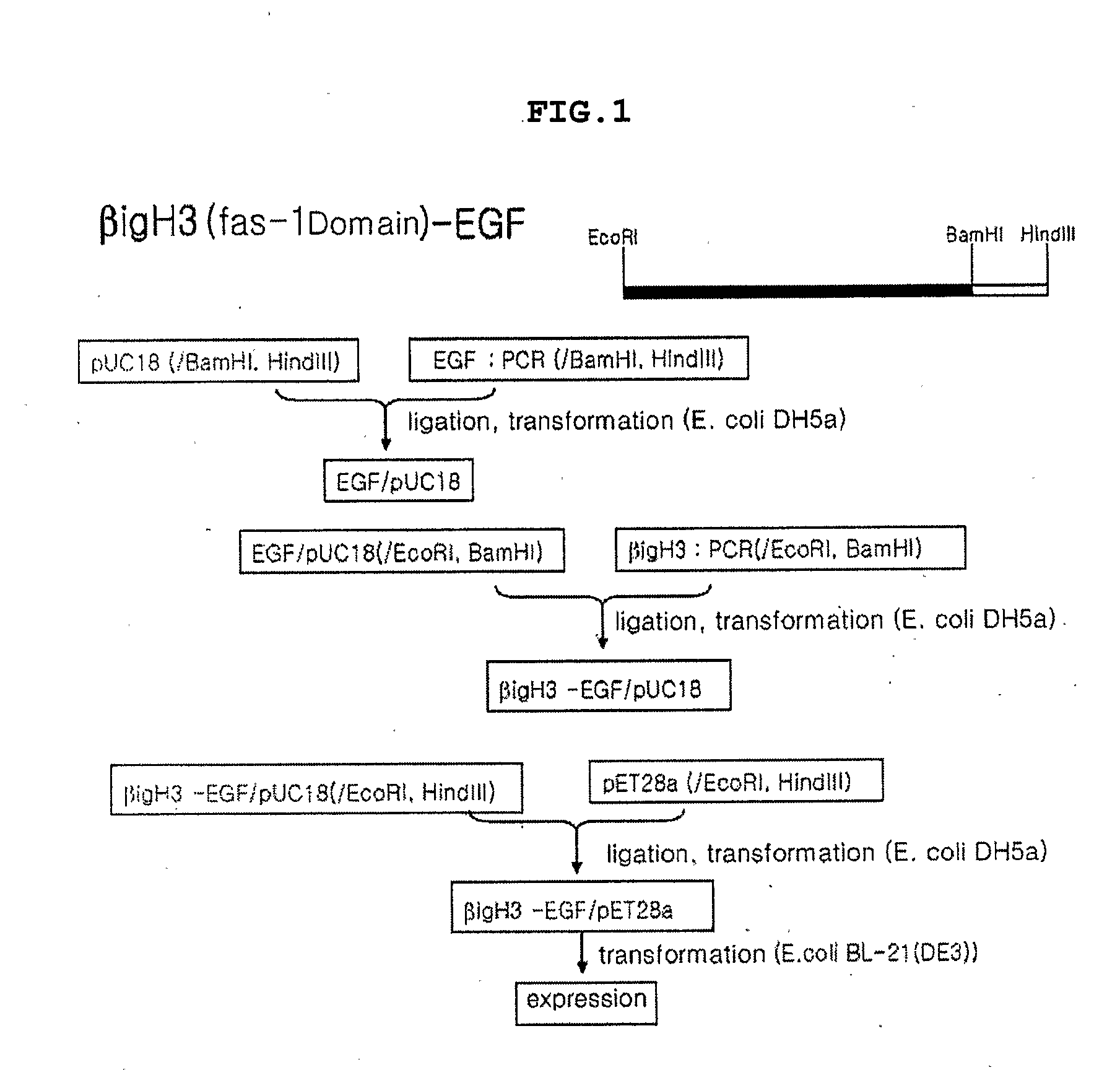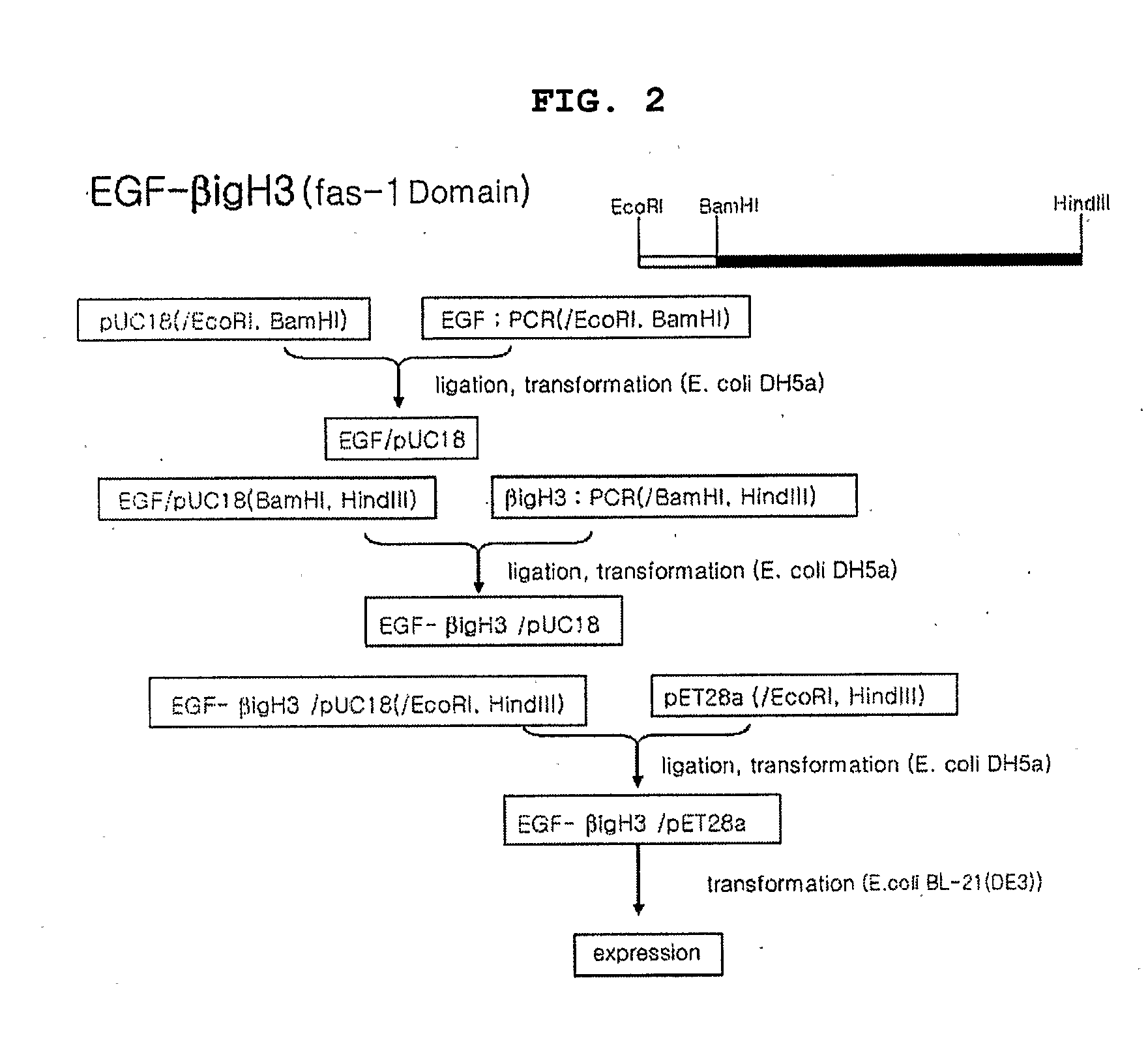Method for Producing Epidermal Growth Factor Using Fusion Proteins Comprising Fas-1 Domain
a technology of fusion proteins and epidermal growth factors, which is applied in the field of fusion proteins, can solve the problems of low recovery, low recovery, unsatisfactory gene expression, etc., and achieve the effects of enhancing the production, stability and functions of human egf, enhancing functions, and improving stability
- Summary
- Abstract
- Description
- Claims
- Application Information
AI Technical Summary
Benefits of technology
Problems solved by technology
Method used
Image
Examples
example 1
Synthesis of a Novel EGF Nucleotide Sequence
[0081]An optimum nucleotide sequence preferred by a plant was designed, which was different from the conventional nucleotide sequence encoding hEGF but was able to encode 53 amino acids (MNSDSECPLSHDGYCLHDGVCMYIEALDKYACNCVVGYIGERCQYRDLKWWELR) equal to the natural hEGF. It was considered for the design of the novel gene that GC content had to be more than 50%, a codon preferred by a plant had to be included and intron-like sequence had to be eliminated. The resultant nucleotide sequence was synthesized at Plant Biotechnology Institute (referred as “PBI” hereinafter), National Research Centre (SK, Canada). The synthetic DNA encoding hEGF is represented by SEQ. ID. No 1.
example 2
Synthesis of a Novel βig-h3 Fas-1 Domain II Nucleotide Sequence
[0082]An optimum nucleotide sequence preferred by a plant was designed, which was different from the conventional nucleotide sequence encoding Fas-1 domain II but was able to encode the nucleotide sequence encoding amino acid sequence containing natural human βig-h3 fas-1 domain II (TNNIQQIIEI EDTFETLRAA VAASGLNTML EGNGQYTLLA PTNEAFEKIP SETLNRILG DPEALRDLLN NHILKSAMCA EAIVAGLSVE TLEGTTLEVG CSGDMLTING KAIISNKDIL ATNGVIHYID ELL). It was considered for the synthesis of the novel gene that GC content had to be more than 50%, a codon preferred by a plant had to be included and intron-like sequence had to be eliminated. The novel nucleotide sequence was chemically synthesized at Plant Biotechnology Institute (referred as “PBI” hereinafter), National Research Centre (SK, Canada). The synthetic DNA encoding fas-1 domain II is represented by SEQ. ID. No 2.
example 3
Synthesis of a Novel βig-h3 Fas-1 Domain IV Nucleotide Sequence
[0083]An optimum nucleotide sequence preferred by a plant was designed, which was different from the conventional nucleotide sequence encoding Fas-1 domain IV but was able to encode the nucleotide sequence encoding amino acid sequence containing natural human βig-h3 fas-1 domain IV (MKETAAAKFEREHMDSPDLGTLVPRGSMADILTPPMGTVMDVLKGDNRFSMLVAAIQ SAGLTETLNREGVYTVFAPTNEAFRALPPRERSRLLGDAKELANILKYHIGDEILVSG GIGALVRLKSLQGDKLEVSLKNNVVSVNKEPVAEPDIMATNGVVHVITNVLQPPANLE). It was considered for the synthesis of the novel gene that GC content had to be more than 50%, a codon preferred by a plant had to be included and intron-like sequence had to be eliminated. The novel nucleotide sequence was chemically synthesized at Plant Biotechnology Institute (referred as “PBI” hereinafter), National Research Centre (SK, Canada). The synthetic DNA encoding fas-1 domain IV is represented by SEQ. ID. No 3.
PUM
| Property | Measurement | Unit |
|---|---|---|
| pH | aaaaa | aaaaa |
| pH | aaaaa | aaaaa |
| speed | aaaaa | aaaaa |
Abstract
Description
Claims
Application Information
 Login to View More
Login to View More - R&D
- Intellectual Property
- Life Sciences
- Materials
- Tech Scout
- Unparalleled Data Quality
- Higher Quality Content
- 60% Fewer Hallucinations
Browse by: Latest US Patents, China's latest patents, Technical Efficacy Thesaurus, Application Domain, Technology Topic, Popular Technical Reports.
© 2025 PatSnap. All rights reserved.Legal|Privacy policy|Modern Slavery Act Transparency Statement|Sitemap|About US| Contact US: help@patsnap.com



